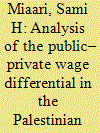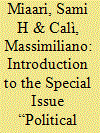|
|
|
Sort Order |
|
|
|
Items / Page
|
|
|
|
|
|
|
| Srl | Item |
| 1 |
ID:
171074


|
|
|
|
|
| Summary/Abstract |
This paper measures and analyzes the dynamics of the public–private wage differential in the West Bank and Gaza for the period before and during the ‘second Intifada’ using data from the Palestinian Labour Force Survey (PLFS) of the Palestinian Central Bureau of Statistics (PCBS). Because the distribution of workers’ individual characteristics, such as skills, and the ‘returns’ to these characteristics may differ across workers, the wage differential is decomposed into two components: an ‘endowment’ effect and a ‘returns’ effect. The results show that in the pre-Intifada period, the wage gap between the public and private sectors narrowed in both the West Bank and Gaza. However, a sharp increase is seen after the outbreak of the Intifada. Moreover, most of this increase comes from an increase in ‘returns’ to skills composition in the public sector, (unexplained effect), rather than a change in the skills composition of public sector workers, (explained effect). Using recent econometric quantile regression techniques, the analysis of the public–private sector wage gap from 1998 to 2006, at various points along the wage distribution, shows that the wage premium, (penalty), for the public sector varies across the distribution, being higher, (lower), at the lowest end of the wage distribution and decreasing (increasing) along the wage distribution; it becomes negative in the top percentiles.
|
|
|
|
|
|
|
|
|
|
|
|
|
|
|
|
| 2 |
ID:
138079


|
|
|
|
|
| Summary/Abstract |
This article investigates whether attacks against Israeli targets help Palestinian factions gain public support. We link individual-level survey data to the full list of Israeli and Palestinian fatalities during the period of the Second Intifada (2000– 2005) and estimate a flexible discrete choice model for faction supported. We find some support for the ‘‘outbidding’’ hypothesis, the notion that Palestinian factions use violence to gain prestige and influence public opinion within the community. In particular, the two leading Palestinian factions, Hamas and Fatah, gain in popularity following successful attacks against Israeli targets. Our results suggest, however, that most movement occurs within either the secular groups or the Islamist groups, but not between them. That is, Fatah’s gains come at the expense of smaller secular factions, while Hamas’s gains come at the expense of smaller Islamic factions and the disaffected. In contrast, attacks by the Palestinian Islamic Jihad lower support for that faction.
|
|
|
|
|
|
|
|
|
|
|
|
|
|
|
|
| 3 |
ID:
175500


|
|
|
|
|
| Summary/Abstract |
The Israeli-Palestinian conflict is the world’s most protracted contemporary conflict and one which has gained international prominence throughout the years. As a result of the Six Days War in 1967, the West Bank and the Gaza Strip fell under Israeli control. The conflict has evolved through ebbs and flows of violence including two Palestinian uprising against Israeli control (the First and Second Intifada). These have led to tens of thousands of Palestinian and thousands of Israeli victims.
|
|
|
|
|
|
|
|
|
|
|
|
|
|
|
|
|
|
|
|
|